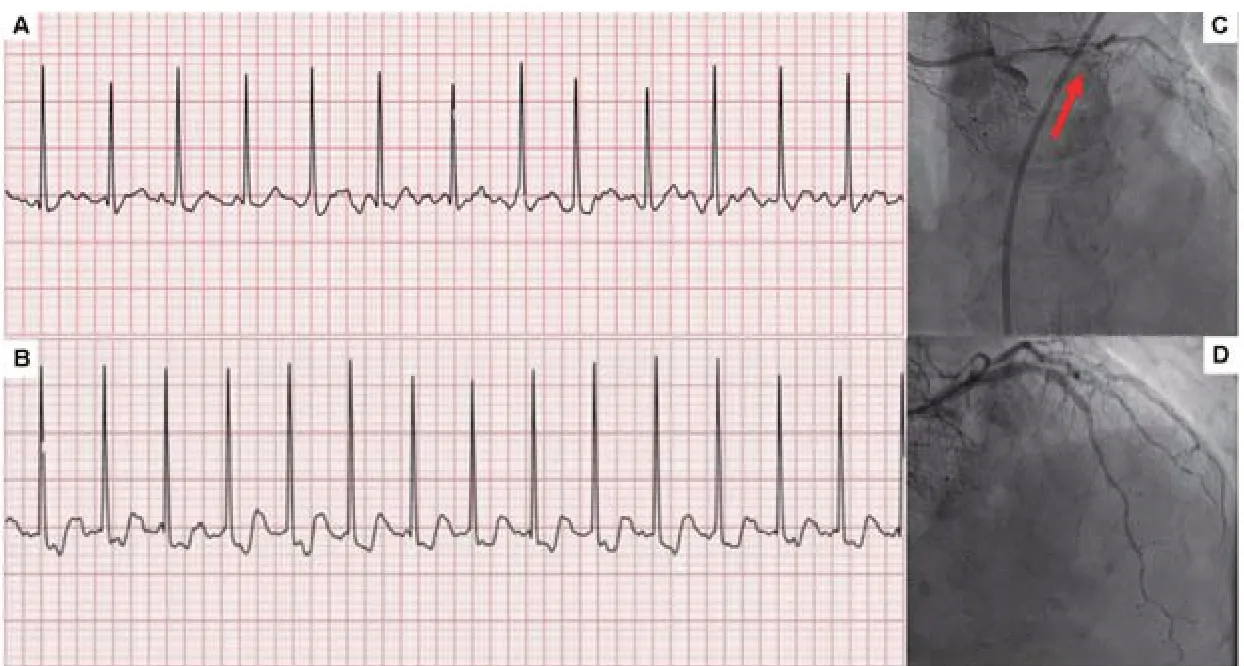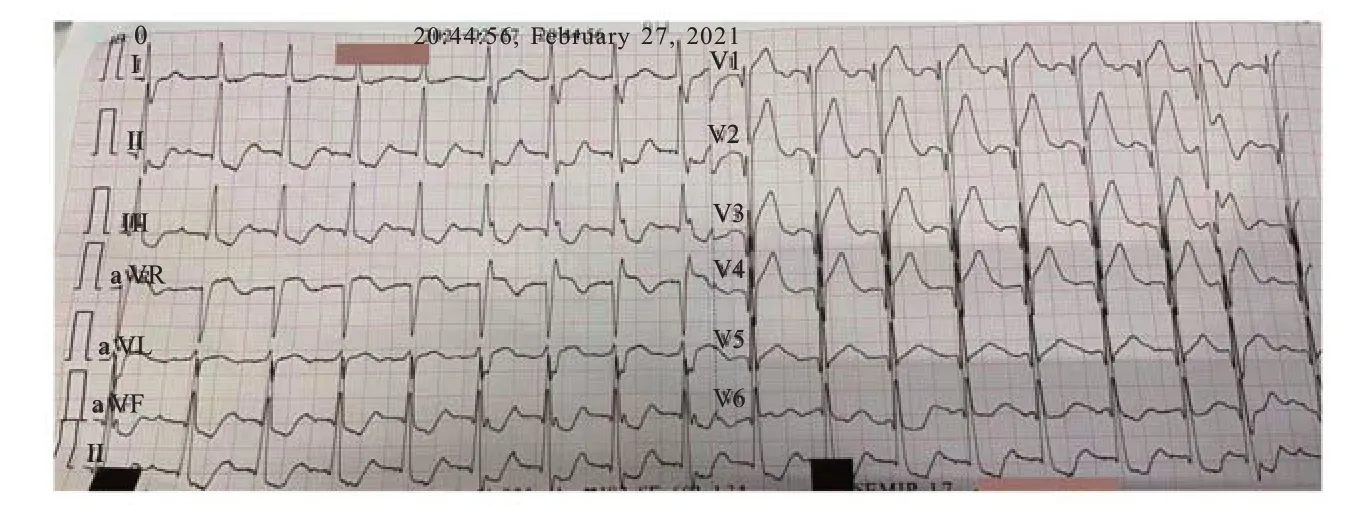Myocardial infarction detected by a smartwatch after transcatheter aortic valve replacement during the COVID-19 pandemic
Xian-bao Liu, Jia-qi Fan, Ye-ming Xu, Yu-chao Guo, Cheng Li , Jian-guo Xu, Jian-an Wang
1 Department of Cardiology, the Second Affi liated Hospital Zhejiang University School of Medicine, Hangzhou 310009,China
2 Zhejiang University School of Medicine, Hangzhou 310058, China
3 Department of Electrocardiography, the Second Affi liated Hospital Zhejiang University School of Medicine, Hangzhou 310009, China
Dear editor,
Transcatheter aortic valve replacement (TAVR) is a safe and effective first-line therapeutic management for patients with severe aortic stenosis.The evidence of multiple randomized clinical trials proves the safety and efficacy of TAVR in patients.[1-2]However, new-onset conduction disorders, atrial f ibrillation, and acute coronary syndrome are still common complications after TAVR procedures.Acute life-threatening complications such as myocardial infarction may result in fatal clinical outcomes.The COVID-19 pandemic makes periodic and timely followups for patients after TAVR more diffi cult.An ambulatory electrocardiogram (AECG) monitoring system by a smart wearable device has recently emerged as a tool to monitor cardiac events before and after TAVR.[3]Smartwatches can monitor and record multiple biometric parameters, like heart rate, step counts, sleep cycles,oxygen saturation, and analyze QRS complexes and P waves after triggering incidences.Apple smartwatches can detect coronary ischemic changes during chest pain episodes.[4]In this study, we reported a patient with acute myocardial infarction after TAVR, who was diagnosed using electrocardiogram (ECG) recorded by a HUAWEI smartwatch and subsequently received percutaneous coronary intervention (PCI) in a timely manner.
CASE
An 80-year-old woman underwent TAVR with self-expanding bio-prosthesis and was discharged on September 19, 2020 (the second day after the TAVR procedure).The past medical history included hypertension and diabetes mellitus.The patient received remote health monitoring with a smartwatch (HUAWEI Watch GT 2 Pro series) and was instructed to activate an ECG recording according to the manufacture setups( SMART TAVR trial, NCT04454177).Her medication after TAVR included aspirin, clopidogrel, repaglinide,levoamlodipine, atorvastatin, and diuretics.On February 27, 2021, the patient experienced typical angina symptoms.A single-lead ECG detected the ST-segment changes when compared with depressed ST-segment in a previously recorded strip (Figures 1A, 1B).The patient was admitted to the local hospital, and the troponin I was 0.169 ng/mL.A 12-lead ECG revealed acute ST-elevation myocardial infarction in the anterior wall (Figure 2).Then the patient was transferred to the catheterization laboratory in our hospital, and a 100% stenosis of the left anterior descending artery was found (Figure 1C).PCI was performed successfully (Figure 1D), and the patient was discharged from the hospital three days later.

Figure 1.Electrocardiography and representative images of cardiac catheterization.A: ST-segment changes when the symptoms occurred; B: depressed ST-segment at baseline; C: percutaneous coronary angiography showing a 100% stenosis of the left anterior descending artery; D: revascularization after percutaneous coronary intervention.

Figure 2.The 12-lead electrocardiogram in local hospital revealed acute ST-elevated myocardial infarction in the anterior wall.
DISCUSSION
Myocardial infarction is a rare but fatal complication after TAVR.Severe coronary ischemia requires emergent interventions.Conventional post-operative follow-ups require the patients to come to the hospitals, but some post-TAVR patients with the onset of chest pain may not be aware of the signif icances of the events, and thus ECG changes of cardiac ischemia can’t be promptly found.As a novel remote follow-up method, the AECG monitoring system has shown its safety, usefulness, and potential clinical implications in TAVR patients.The advances in smart technologies, such as smartphones or watches, make AECG monitoring feasible and aff ordable for patients after TAVR procedures.The SMART TAVR trial, which allows patients to be discharged on the second day after TAVR with a smartwatch, is designed to show that utilizing smartwatches results in a shorter length of hospital stays and promotes out-of-hospital management during the COVID-19 pandemic.
This successful case implies that AECG monitoring by a smart wearable device may be applied to detect arrhythmia and myocardial ischemia.The smartwatch makes patient health care to be more convenient and reliable during the COVID-19 pandemic.In the future,more data are needed to prove the eff ectiveness of post-TAVA follow-ups with smart technologies.
ACKNOWLEDGMENTS
The authors are gratefully thankful to Huawei Heart Health Research Team led by Xiao-xiang He for the their development and optimization of ECG algorithm.Team members include Jia-bing Yan, Wen-juan Chen, Lian Wu,and Jian-hua Guo.
Funding:None.
Ethical approval:The study was approved by the ethics committee of our hospital.
Conflicts of interests: The authors declare that they have no competing interests.
Contributors:All authors have substantial contributions to the acquisition, analysis, or interpretation of data for the work.All authors read and approved the final version of the submitted manuscript.
 World journal of emergency medicine2021年3期
World journal of emergency medicine2021年3期
- World journal of emergency medicine的其它文章
- Chemical pneumonitis caused by intravenous injection of insecticide spray
- Mediastinum metastasis in a post-surgical pancreatic cancer patient successfully conf irmed with endoscopic ultrasonography
- Biphasic anaphylaxis manifested as type I Kounis syndrome induced by ingestion of raw f ish gallbladder: A case report
- Tension hydropneumothorax in a Boerhaave syndrome patient: A case report
- Performance of extracorporeal membrane oxygenation in patients with fatal paraquat poisoning:grasp for straws?
- Intravenous haloperidol for the treatment of intractable vomiting, cyclical vomiting, and gastroparesis
